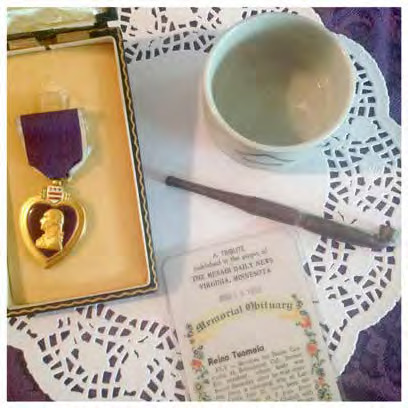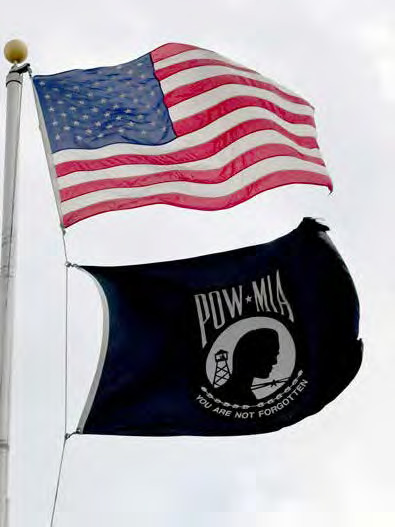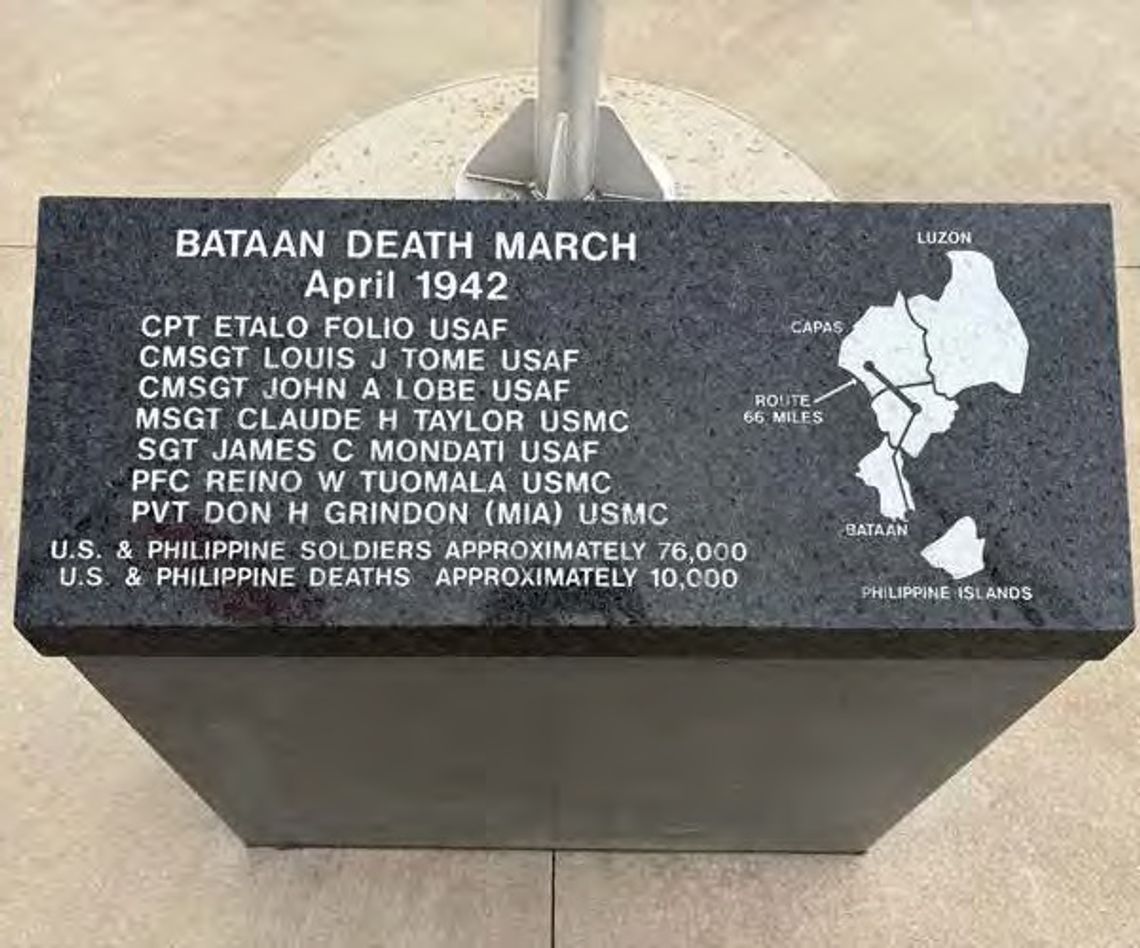I am sitting on my couch in my warm house after finishing a book called, “Horrid Trek,” by Robert Woodrow Levering. This is a true story of Bataan, the Death March and three and one-half years in Japanese prison camps. My mind and body are in a state of shock to have read what happened to our American patriots.
I knew of the Bataan March as one of my uncles, John Lobe, was one of the eight young soldiers from Ely that endured the horrific abuse after being captured as a POW by the Japanese during World War II. Through the years I had heard about Bataan through relatives but never paid much attention to exactly what it was.
The eight Ely soldiers that became POWs during the Bataan March were:
Louis “Gigi” Tome - Survivor
Donald Debler – Died in Prison Camp
Jim Mondati – Died during the March and is listed as MIA
Reino Tuomala - Survivor
Don Grinden – Lost his life when prison ship was sunk
John Lobe - Survivor
Ed Folio - Survivor
Claude Taylor - Survivor
In my younger years, I was busy raising a family and working that I did not have time, inspiration, knowledge, or desire to reach out to my uncles and aunts and get information firsthand on what truly happened to Uncle John. Now, so many years later, all knowledge and stories held by my relatives went to the grave. When I reached out to descendants - children and grandchildren of the soldiers, they were too young to understand other than remember a few passing comments. Throw in that mix most of the survivors did not wish to talk in any length about the ordeal they barely lived through.
The Bataan Death March stands as one of the darkest and most harrowing episodes of World War II — a brutal ordeal that tested the limits of human endurance and exposed the cruelty of war. It began in April 1942, following the fall of the Bataan Peninsula in the Philippines to Japanese forces. It left an indelible scar on both American and Filipino history. The March was the forcible transfer of 72,000 to 78,000 American and Filipino prisoners of war on the Bataan Peninsula in the Central Luzon region of the Philippines.
When Japan attacked the Philippines in December 1941, it was just hours after striking Pearl Harbor. American and Filipino forces under General Douglas MacArthur fought valiantly to defend the islands. Outnumbered and undersupplied, they held their ground for months on the Bataan Peninsula. Disease, hunger, and exhaustion ravaged the troops, yet they resisted until April 9, 1942, when Major General Edward King Jr. made the difficult decision to surrender at the point of knowing further resistance was impossible.
What followed was an unimaginable nightmare as the thousands upon thousands of soldiers were forced to march approximately 65 miles from Mariveles, at the southern tip of Bataan, to San Fernando in Pampanga. From there, they were packed into overcrowded boxcars and transported by rail to Capas, Tarlac, then marched again to Camp O’Donnell, a former Philippine Army base turned prison camp.
The journey took days under a scorching tropical sun, with no adequate food or water. Anyone who collapsed from exhaustion, illness, or dehydration was beaten, bayoneted, beheaded, or shot by Japanese guards. Prisoners were denied medical treatment, and the sick were left to die along the roadside. Civilians who tried to help were often killed as well.
Soldiers struggled with dysentery, beriberi, malaria, scurvy, dengue fever, dehydration, and starvation. The average survivor’s life was cut short by an average of 15 years. Most soldiers returned as skeletons with their weight dropping well below the 100 pound mark. The average weight of a U.S. soldier entering World War II was 144 to 170 pounds. This, of course, varied based on factors of age, height, and regional recruitment differences.
By the time the March ended, thousands were dead - estimates vary, but historians believe between 9,000 and 11,000 prisoners perished along the way. Those who survived the march faced further suffering in the prison camps, where disease, starvation, terrific beatings, murder, and neglect claimed many more lives.
The survivors carried lifelong physical and emotional scars and PTSD was not in existence to be able to diagnose and treat their physical, emotional, and mental concerns. Their stories, later shared after liberation in 1945, revealed the full horror of what they had endured.
After the war, the Bataan Death March became a powerful symbol of sacrifice, endurance, and the shared struggle of Americans and Filipinos. In 1946, a U.S. military tribunal convicted several Japanese officers of war crimes for their role in the atrocities.
Today, the courage of those who suffered and died on the march is honored in memorials across the Philippines and the United States. Every year, commemorative events such as the Bataan Memorial Death March in New Mexico remind new generations of the cost of freedom and the resilience of the human spirit.
The Bataan Death March was not just a military tragedy—it was a human one. It revealed the depths of cruelty that war can unleash, but also the strength, brotherhood, and courage that can appear in its face. Remembering Bataan ensures that the suffering and heroism of those who endured it will never be forgotten.
Those of us who never understood or educated ourselves on the atrocities of war should take the time to do just that. My father was a WWII veteran, and I now understand why he treated food with such honor. We, meaning those of us who have never been hungry, do not understand what true starvation or the craving of a glass of clean water means to those who are or went without.
I did some research for this column and one of my deepest desires was to write about these men personally. I took a photo of the monument with each of these men’s names engraved on it. This was a tough assignment I gave to myself as they returned from the war 80 years ago. Records were not kept as they are today. I wish to give homage as best as I can to each one with what I will share here.
One of my classmates and dear friends had the privilege to have one of these men as her father. This woman is Jean Folio Nappa, and her father was Captain Etalo (Ed/Eddie) Folio, USAF. Jean lost her father on November 11, 1979, at the same time Jean was giving birth to her first son – Ed’s first grandchild. His grandson has been taught his grandfather lived a life of sacrifice and courage.
It was very symbolic that Ed passed away on Veterans Day to join his departed comrades as the last northeastern Minnesota survivor of the March. He left this earth as his grandbaby arrived in the same hospital – one angel in and one angel out.
Ed, who was 24 years old when he enlisted in the U.S. Air Force, spent three years, five months, 27 days, and 11 hours in hellish concentration prison camps of the Japanese Imperial Army. His last prison camp was in Fukuoka Province in Japan where he was assigned to the Yawata Steel Plant with 700 other American, British and India prisoners.
The Yawata Steel Plant was the number one target for the atomic bomb and the only thing that saved Ed, and the other men was the fact that the area had been hit by bombers just before and smoke created poor visibility over the target, so they went to Nagasaki and dropped the atomic bomb there.
When talking with Jean and reading his obituary, I learned Ed was a quiet man of courage, an honest, hardworking, and dedicated employee, husband, father, and a patriot to his core. He was an employee at Forest Chevrolet in Ely and managed the parts department. His employer, John Artisensi, spoke very highly of Ed and his incredible work ethic and mentioned he was vital to the success of the dealership. Ed was born on February 20, 1920, and passed at the early age of 59.
Cpl. Louis J. “Gigi” Tome, enlisted into the U.S. Air Force when he was 24 and is listed second on the Bataan Death March plaque. I do not know of any his family members, but I read a little about him in the book, “Ely, Since 1888,” in an article written by the late Irene Grahek. Gigi made it through the war and stayed with the Air Force until he suffered a fatal heart attack in 1970.
Gigi did help to save fellow Elyite soldier Claude Taylor who was so ill at Cabanatuan prison camp that he was placed in what they called the “zero stall” of the sick bay. This was a place where dying men were put. Fortunately, Claude was brought back to life by Gigi Tome and Ed Folio who found him and forced him to eat and take liquids or he would never have made it. Both Gigi and Ed gave up their daily rations and water for a few days to save Claude’s life.
The third name on the marble plaque is my uncle CMSGT John C. Lobe USAF. He was the oldest of the eight Ely captives – enlisting in the U.S. Air Force at the age of 32 and worked as an aircraft gunner. I remember hearing he said that all the planes made it to the airfield in the Philippines, and he watched as they were all destroyed by enemy fire while on the ground. Through the smoke, fire and dust he could see the propellers still moving on the grounded planes.
John was a quiet man who married my dad’s older sister Mary Mavetz Rudnick, who was a widow living in Milwaukee. They met after the war when my aunt was in Ely on a visit to her family. They both had a love for the lakes, season changes, and fishing. John and Mary had a short courtship until he proposed to her, and they then married. John then moved with Mary to West Allis, Wisconsin, which is a suburb of Milwaukee. He stayed there until his passing on January 6, 1977.
John was a true patriot his entire life. He passed at the age of 67. Memories of him include how he always had a smile for everyone. He wore dentures early on in life due to the erosion of his teeth blamed on the terrible conditions and hygiene he endured as a prisoner of war.
On visits to Ely, John was known as an avid card player and angler. He enjoyed reliving his boyhood solitude on Jasper and Fall Lakes - fishing to his heart’s content. His heart never left his boyhood city of Ely. He was laid to rest in Wood National Cemetery in Milwaukee, Wisconsin.
MSGT Claude Taylor served in the U.S. Marine Corp enlisting at the age of 23 and spent most of the duration of World War II as a POW. He was the youngest of the eight Ely boys that marched during the Bataan captivity. He never hesitated to talk about his experiences both tragic and humorous. He survived because of his wits and determination and looked upon that part of his life as just another chapter.
Claude enlisted in the Marines in 1939 and was in the Corp two years before the war broke out. He was stationed in Shanghai ready for something to happen and not sure what until the attack on Pearl Harbor. Six months later, on April 9, 1942, the Marines evacuated Bataan, escaped to Corregidor, and forced to surrender one month later on May 6th.
Claude was quoted that the treatment he received was from drastic to almost decent and varied from group to group because no set policy was in force. The guards were allowed to treat prisoners as they wished. If one man tried to escape or steal food, many times punishment was dealt out to all the prisoners rather than just the one who stepped out of line.
Claude entered the service weighing a healthy 175 pounds. and during his imprisonment dropped to as low as 85 to 90 pounds. During his time on his deathbed, imagine how he woke to find himself in the hands of two of his hometown buddies - Gigi Tome and Eddie Folio.
Gigi and Claude managed to stay together for the duration of their captivity and were joined by Reino Toumala until 1944.
Claude said the prison camp was crawling with rats which were sometimes eaten by the men when hunger overtook judgment. Claude says he could never quite accept that as food. One day his usual cup of rice was much more substantial. A buddy had managed to capture the camp commander’s cat and kittens. The entire camp was punished because the commander never really knew what happened to the cat or who had committed the “criminal act.”
Rules were always being enforced but the one requirement Claude tried to avoid was learning to count off in Japanese. He felt that learning the language on top of the injuries was more than he could stand. He managed to evade that requirement for two years by staying out of the front ranks, but one day it caught up with him. For his insolence he was tied to a post for 72 hours with a sentry, who took turns with other guards, teaching him to count in Japanese. Whenever Claude fell asleep, he was doused with a pail of water. Until the day he died, he said he could count well in Japanese.
Atrocities were commonplace such as the time one soldier was beheaded in front of the entire camp because he had attempted an escape. His executioner was the camp commander - tenderly referred to as, “the White Angel,” because he wore an immaculate white uniform. These types of scenes were commonplace for the men held as captives.
These men were given such poor food and water and very little of both. Most days they were fortunate enough to get about 1/3 of a cup of rice or on exceedingly rare occasions, twice a day. They were served a watery “soup’ made solely with the tops of radishes or sweet potatoes. Rarely, there was a thimble or two of meat put in the “soup” or the Japanese captors would laugh as they emptied fly traps into the makeshift meals served to the prisoners.
Next on the plaque was SGT James C. Mondati USAF. He was 25 years old when he enlisted in the U.S. Air Force. Reports were that Jim was shot to death at age 22 on July 4, 1942, during the March on the way to Cabanatuan, Nueva Ecija Province, Central Luzon, Philippines. His remains were most likely buried along the roadside; however, his name is engraved on a monument at the Manila American Cemetery and Memorial in Manila, Capital District, National Capital Region, Philippines.
PFC Reino W. Tuomala USMC was another Ely survivor of the Bataan Death March. He enlisted into the Marine Corp at the age of 26. He was wounded twice in action and awarded the Purple Heart.
I was fortunate to have found his only child – a daughter, Glenna Marks, who lives in Santa Clara, California. She was 9 ½ years old when her father Reino passed away on July 20, 1962, at the age of 44 years, 9 months, and 3 days. He was on a fishing trip in Quetico Park on Lac LaCroix Lake in Atikokan, Ontario, Canada when he died from exposure and exhaustion. He is buried in the Ely Cemetery even though he lived in Sebastopol, California.
Reino was a proud 100% Finlander at heart, a wonderful soft man, and a true patriot. His brother George enlisted in the Navy during the World War II and was commissioned in the South Pacific. George’s hope was that he would through the grace of God be able to find his imprisoned brother while he was serving.
Reino’s daughter posted a photo on Facebook that speaks a thousand words. I have included this incredible image in this column with the following description written by Glenna:
“One of the first songs I learned as a child was the Marine Hymn. The bowl that appears in this picture was used during his captivity as a prisoner of war. He would get this filled with rice once a day. The pipe was used to smoke human hair because there was no tobacco. He made it through “The Death March,” four years of prison camp, and two wounds. You will always be my hero daddy! Thank you for your service! This little girl will never forget!”
After Reino left the service, he was employed at the Hamilton Air Force Base in Novato, California as a carpenter. Glenna said when he got home from work, he always smelled like fresh cut wood and to this day the smell still brings back fond memories of her father. Glenna said his carpentry skills were amazing, and he learned those from his Ely Memorial High School shop classes.
I did not find out much about the last guy on the memorial plaque – PVT Don H. Grindon USMC other than he is listed as MIA (missing in action). He was aboard one of the prison ships enroute to another prison camp when it was hit by a torpedo from American submarine and sunk. The submarine crew was not aware that the ship held any Americans until afterwards.
There was one soldier who was not on the Veterans memorial plaque, but I found his name in an old article. This man was PFC Donald D. Debler, USMC who was officially reported as missing in action as of May 7, 1943. He was 27 at the time of his enlistment into the Marine Corp. His remains were never found, but his service, dedication and loss of life is worth noting and remembering.
The Bataan Death March was tragic chapter in World War II history. As I write this, three words keep coming into mind - Lest We Forget. This is a three-word phrase that emphasizes the need to remember all the men and women who bravely gave their lives during wars. The literal translation of those three words simply means, “It should not be forgotten.” The phrase subtly projects a warning that we do not forget those who have lost their lives at war while we live through times of relative peace.
This phrase is from the poem, “Recessional” by Rudyard Kipling and written for Queen Victoria’s Diamond Jubilee in 1897. It only became to be adopted in its current use around a decade from the end of the first World War.
As time marches forward and our country’s history has been seemingly pushed aside, I am particularly passionate about writing about what my family members had lived through and the importance of remembering these great men and women who stood for our freedom that we enjoy every day as we live in the United States of America.
We are celebrating Veterans Day on November 11. In the United States, Veterans Day is a national holiday to honor veterans of the armed forces and those killed in the country’s wars. To note, November 11 became an official national holiday in the United States in 1938. In 1954, the name was changed to Veterans Day from Armistice Day to honor those who had served in all U.S. wars.
For most of the men that survived Bataan, the Death March never ended. My father used to tell us when we were young that we should always put ourselves in the shoes of others. In the case of these brave men, that would be boots. I would not have a clue to try to do what my dad suggested.
I know growing up my father was adamant about having food on the table. He would always tell us how lucky we were to always have something to eat. We silently scoffed or rolled our eyes because we were never hungry. My dad was involved in five battles in the European theatre in World War II and I do remember him mentioning how hungry they would get when rations were low or not at all.
After reading repeatedly about the lack of food and water the prisoners of the Japanese had to deal with, it made sense why my dad loved to cook, garden, and serve wonderful food to our family of six. He always told us if there was one thing we could have and appreciate in this world, it was food.
The soldiers that came back to tell their stories, mentioned how food was the biggest topic while they were in captivity. They would tell stories of what their mothers and grandmothers would prepare and what their first meal would be when they would return home. The food conversations would sometimes become too much to bear for some that they were driven to steal food, and their lives were ended because they were caught in the process or were found out of their success.
We take so much for granted in this overly blessed country in which we live. Food is so abundant in our country. In my life of 64+ years, I have never known hunger. We take food for granted and think nothing of letting food spoil and must throw it out without any care. I feel guilty for all I have wasted.
These eight Ely boys were young, strong, and robust men whose lives were not easy. They all lived through the Great Depression and that was somewhat of a training ground for what was to befall them during the war.
My parents lived through the Depression and told stories of how scarce money, food and supplies were and how there were no extras. Food was grown locally by families in backyard gardens and root cellars and home canned goods kept them alive during the long cold winters. My father quit school in the eighth grade when he was 14 years old to go to work to help his parents monetarily.
Hate is/was at the core of all the atrocities during every war and throughout all societies to this day. My father would always preach to us when he would hear us say we hated someone. He would repeatedly tell us to never use the word hate because of the destructiveness of it. Money may be the root of all evil, but Hate must be a close second.
My father, uncles and others who lived through experiences and knew hate at its worst. I went through times in my life when I truly disliked people and used the word hate. When I did, I would cringe knowing what our father would preach to us about that word. It divides people and is most certainly a favorite ploy of the devil.
We can read all the excerpts and books written about the Bataan Death March but will never truly know the horror these men saw and lived through. I find it absolutely astounding that our tiny northern Minnesota town of Ely sent many soldiers off to war and eight of these young men ended up on the Bataan Peninsula.
Five of these boys returned and became extremely strong men throughout their captivity. To accomplish this feat, they had to beat many odds of which they were up against. This is especially notable when nine out of every American soldier in the March died or were killed while under the control of the Japanese.
These facts put a bold exclamation point on the strong character and perseverance carried by these men. I attribute these skills were put into these men by their tough immigrant parents and/or grandparents plus their life experiences before the war.
All that is left of these great men are a handful of yellowed, faded newspaper clippings, a few photos and fading memories. Other than grave markers and plaques such as what we have at the Veterans Memorial in Ely, what these men gave has been washed away due to time and distance from their stories of torment and sufferings.
The last of the Bataan Death March survivors have passed onto glory. They are now all at peace in eternal rest in the arms of our Lord. I personally knew one of these great men – even though my memories are few. I wish I could have known them all.
Something we can all learn and carry forward in the honor of all these men is to remove hate from our vocabulary and our lives. My father was once again right as to how destructive that four letter word can be and is. It is a simple thing that can change attitudes and bring forward more love.
This truly is a simple concept: Love, not hate…my dad said so.














